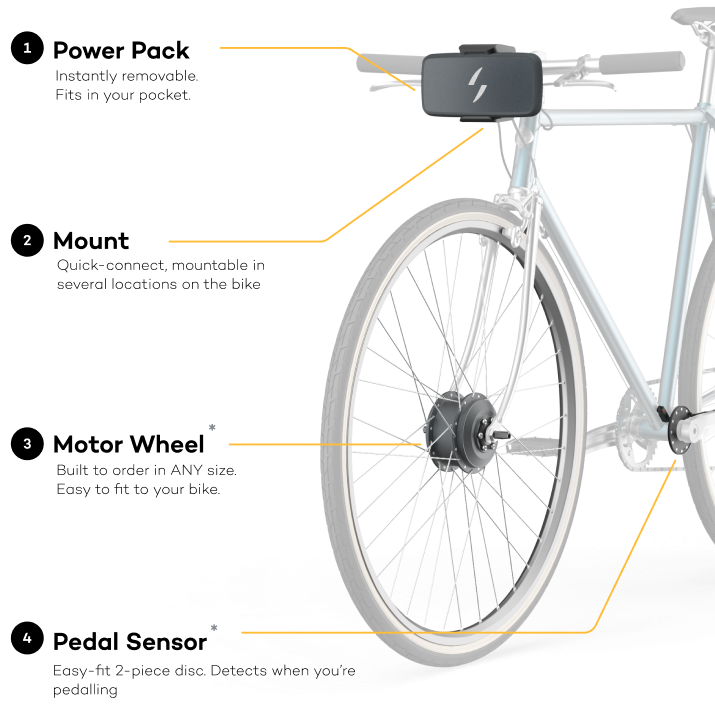In the high-speed universe of metropolitan driving, finding a maintainable and productive method of transportation is more vital than at any other time. Enter the Swytch Bicycle, a progressive electric bicycle changing how we explore our urban communities. In this complete aide, we’ll dig into the elements, benefits, and general effects of Swytch Bicycle on the cycling scene.
The Swytch Bicycle Insight: Releasing the Force of Electric Driving
Power-Stuffed Execution

At the core of the Swytch Bicycle experience is its incredible electric power. With a state-of-the-art engine flawlessly incorporated into the front wheel, Swytch Bicycle offers a solid lift to your acceleration, making uphill trips and significant distances a breeze. The engine, outfitted with best-in-class innovation, guarantees a smooth and proficient ride, whether cruising through the city or handling testing landscapes.
Unrivaled Comfort
Swytch Bicycle stands apart for its benefit, giving an imaginative answer to the last-mile issue. The bicycle includes a lightweight and minimal plan, making it simple to move through jam-packed roads and easily convey up steps or onto public transportation. The bicycle’s foldable ability guarantees it fits flawlessly into your daily practice, permitting you to stash it away in little spaces at home or the workplace.
Eco-Accommodating Driving
Embracing the Swytch Bicycle implies embracing a manageable and eco-accommodating method of transportation. With zero discharges and an electric-help framework that energizes acceleration, you diminish your carbon impression as well as contribute to establishing a cleaner and greener metropolitan climate. Swytch Bicycle is a distinct advantage for people who make naturally conscious decisions in their daily routines.
State of the art Innovation: Behind the Swytch Bicycle Development
Savvy Power Pack
One key highlight separating Swytch Bicycle is its savvy power pack. The reduced and separable battery flawlessly coordinates with the plan, considering simple evacuation and charging. The cutting-edge innovation inside the power pack guarantees ideal energy effectiveness, giving riders the certainty to handle longer distances without stressing over running out of force.
Natural Control Framework
Swytch Bicycle flaunts a natural control framework that places the rider in order. The handlebar-mounted show gives constant speed, distance, and battery duration data. With numerous power-help levels to browse, riders can modify their experience, whether searching for a comfortable voyage or a challenging exercise. The effortlessness and easy-to-understand interface make Swytch Bicycle available to riders of all experience levels.
Powerful Form Quality

Solidness and unwavering quality are vital regarding electric bicycles, and Swytch Bicycle follows through on the two fronts. Created from excellent materials, the bicycle’s casing isn’t just lightweight and solid enough to endure the afflictions of everyday driving. The meticulousness in planning and development guarantees a smooth and safe riding experience, making Swytch Bicycle a drawn-out interest in your driving requirements.
Joining the Swytch Upheaval: Advantages for Riders
Wellbeing and Wellness Lift
While Swytch Bicycle gives electric help, it urges riders to pedal, advancing a solid and dynamic way of life. Driving on a Swytch Bicycle turns into an everyday workout practice, adding to working on cardiovascular well-being, improved perseverance, and, generally speaking, prosperity. The electric-help highlight guarantees that riders can handle their work levels, making it open to people with shifting wellness levels.
Cost-Effective Driving
Possessing and keeping a vehicle can be exorbitant, as can public transportation costs. Swytch Bicycle offers a practical other option with negligible upkeep and charging fees. Express farewell to stopping charges, fuel costs, and the pressure of gridlocks – Swytch Bicycle permits you to explore the metropolitan scene without burning through every last dollar.
Efficient Drives
This enables riders to wind through traffic and explore clogged regions effortlessly. With the electric-help highlight, you can easily make more progress, transforming long and monotonous drives into productive and efficient excursions. Show up at your objective quicker and fresher, prepared to handle the day with newly discovered energy.
The Fate of Metropolitan Versatility: Swytch Bicycle’s Effect
Lessening Gridlock
As additional people embrace electric bicycles like Swytch, the potential for lessening gridlock in metropolitan regions becomes apparent. Minimized and coordinated, Swytch Bicycles can explore through restricted spaces, offering a commonsense answer for the difficulties presented by jam-packed city roads. By picking Swytch, riders add to a smoother and more productive traffic stream.
Encouraging economic urban areas
This lines up with the worldwide push towards maintainability. As urban communities endeavor to decrease discharges and make eco-accommodating transportation organizations, electric bicycles are vital in accomplishing these objectives. Swytch Bicycle’s obligation to natural cognizance positions it as an impetus for cultivating economic urban communities and empowering a shift towards greener driving propensities.
People group and Network

That isn’t simply a method of transportation; it’s a local area. The developing organization of Swytch riders encourages a feeling of Network and shared values. Joining the Swytch people group opens up valuable doors for bunch rides, occasions, and typical energy for practical metropolitan versatility. Be necessary for a development reshaping how we see and draw in with our urban communities.
Conclusion
Swytch Bicycle isn’t simply an electric bicycle; it’s an extraordinary power in metropolitan driving. From its power-stuffed execution to its creative innovation and the horde benefits it offers riders, that is rethinking how we travel through our urban communities. By picking Swytch, riders add to a reasonable and compelling future where driving isn’t simply a need but a charming and eco-cognizant experience. Join the Swytch unrest today and reform your ride.
FAQs
How quickly could a Swytch at any point Bicycle go?
The Swytch Bike can show up at up to 15.5 mph (25 km/h). This speed permits riders to explore metropolitan conditions proficiently while keeping a protected and controlled pace.
What is the scope of the Swytch Bicycle on a solitary charge?
The extent of a Swytch Bike depends upon various components, including the domain, rider weight, and picked help level. In light of everything, riders can expect an extent of 20-50 miles (32-80 km) on a singular charge. The bike’s clever power and the chief’s structure further develop battery use for widened adventures.
What amount of time is required to charge the Swytch Bicycle’s battery?
The charging times for the Swytch change depending on the battery limit. Mostly, it requires around 3-4 hours to charge the battery completely. The removable power pack helps set the bicycle on and off.
Is the Swytch Bicycle reasonable for all wellness levels?
Indeed, the Bicycle takes exceptional care of riders of differing wellness levels. Various power levels can change the electric-help component, “Riders are allowed to choose the level of assistance that best suits their needs.” inclination. This adaptability makes it available to the two fledglings and experienced cyclists.
Should I utilize the Swytch Bicycle in severe weather conditions?
The Bicycle is intended to endure run-of-the-mill atmospheric conditions, including light downpours and snow. Be that as it may, it’s fitting to stay away from delayed openness to weighty downpours or outrageous climates. The bicycle’s parts are climate-safe, yet riders should avoid potential risks to safeguard the electronic components during unfavorable circumstances.
What amount does the Swytch Bicycle gauge?
The greatness of the Swytch Bike varies depending upon the model and judgments. Considering everything, Swytch Bicycles weigh between 14 and 17 kg (31 and 37 lbs). The lightweight game plan improves on it to make due, convey, and store, upgrading its reasonableness for ordinary driving.
Are new parts promptly accessible for the Swytch Bicycle?
Indeed, Swytch Bicycles are planned in light of easy-to-use upkeep. New parts and extras are promptly accessible through the authority Swytch site. Also, the organization provides thorough aides and client care to help riders keep up with their bicycles.
Is the Swytch Bicycle appropriate for rough terrain riding?
While the Bicycle is principally intended for metropolitan driving and cleared surfaces, it can significantly deal with rockaways and light and rough terrain trails. In any case, it’s vital to remember that the bicycle is planned for something other than severe and rugged terrain use. Riders ought to be alert and comply with suggested use rules for the bicycle’s best riding experience and life span.








